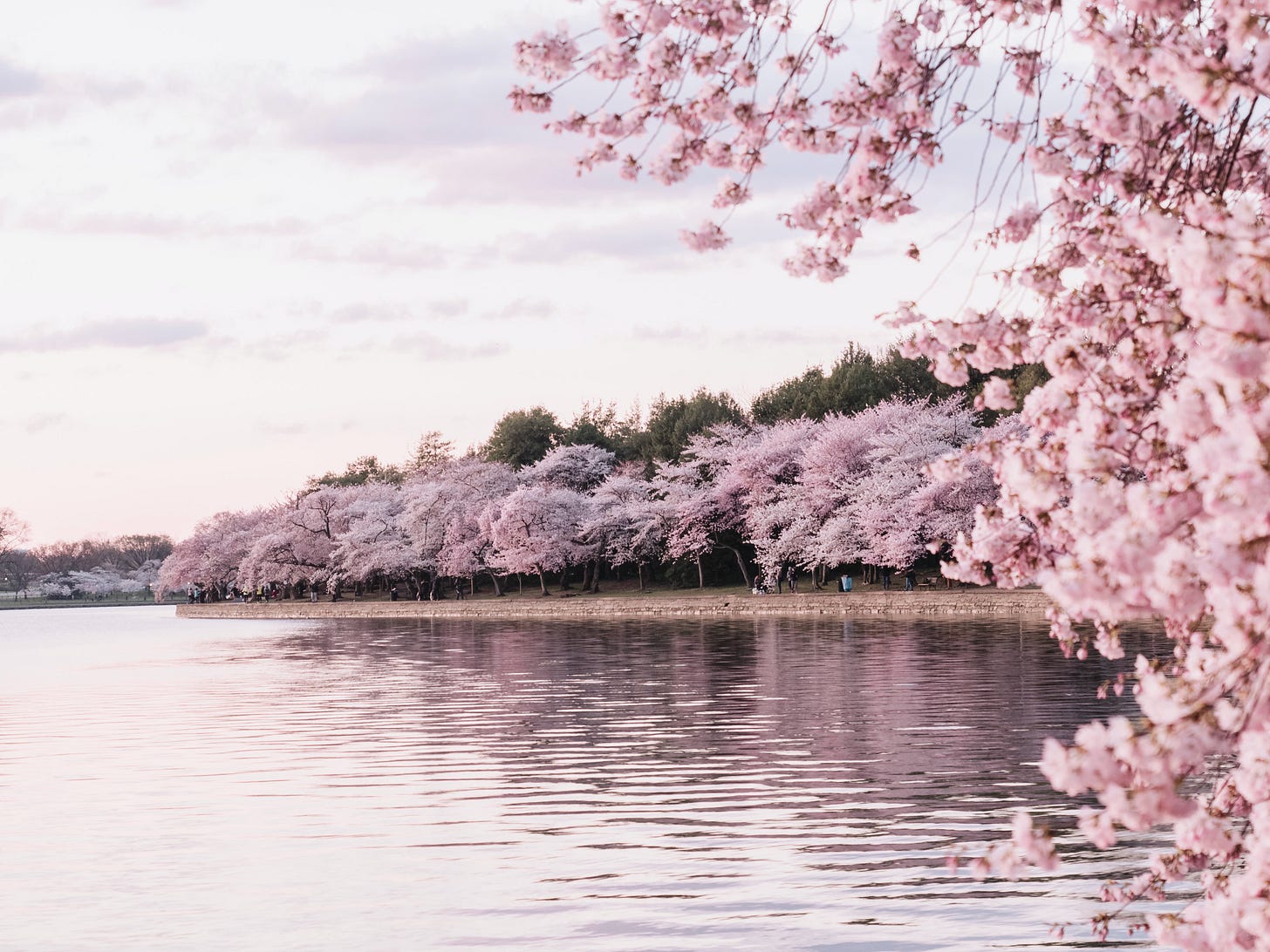Loveliest of trees, the cherry now
Is hung with bloom along the bough,
And stands about the woodland ride
Wearing white for Eastertide.
Now, of my threescore years and ten,
Twenty will not come again,
And take from seventy springs a score,
It only leaves me fifty more.
And since to look at things in bloom
Fifty springs are little room,
About the woodlands I will go
To see the cherry hung with snow.
In these twelve simple lines of verse, clear and fresh as a spring breeze, A.E. Housman (1859–1936) offers us a meditation on time and natural beauty and the value of seeing. According to Dr. Oliver Tearle, “Loveliest of Trees, the Cherry Now” can be seen as a kind of carpe diem poem—an invitation to “seize the day,” take advantage of the joy life has to offer while we still can. Though the poem follows a simple meter or pattern (three quatrains of iambic tetrameter in couplets, to put it technically), its themes are anything but shallow.
In the first stanza, the speaker of the poem sets the scene: a woodland in spring, dotted with cherry trees. Housman personifies the tree, using alliteration to suggest that it “wears white,” as one would put on a coat. The whiteness comes doubly from the light-colored blossoms and the covering of snow that still remains from winter. It is white for a reason: in honor of Eastertide, the liturgical time following Easter Sunday, and traditionally ending on Pentecost Sunday. The liturgical color for Easter is white. As Dr. Tearle points out, whiteness and snow are also traditionally symbols of freshness, purity, and new beginnings, which might point to the idea that the speaker is resolved to start a new way of life in which he will make the most of the time left to him.
In personifying the tree and connecting its color to Eastertide, Housman suggests an intelligible purpose to the state of the tree; its whiteness is not chance, but has a deeper symbolic meaning to it that mysteriously correlates to human life. As a classical scholar and professor of Latin at Cambridge University, Housman would have been familiar with the Ancient Greek tendency to view nature as containing meaning and purpose, not just a random conglomeration of atoms or blind processes. For the Greeks, a river is not just water—it has an essence to it, a spirit manifesting in the river god. It has agency. There are powers at work in and through the river that have, perhaps, even greater intelligence than the human. Unlike the Greeks, we, in our post-scientific revolution world, tend to see nature as a vast, blind, machine, assembled by mere time and chance, with no inherent meaning or purpose. It takes a poet to remind us of this other, older view of rocks and rivers and trees and blossoms.
In the second stanza, Housman strikes a new and unexpected note. This stanza amounts to a puzzle or a math problem to solve. The speaker of the poem tells us his age through an intricate device. Let’s decipher it. A score means twenty, so three score would equal sixty. He adds another ten to get seventy. Seventy what? Seventy years of life allotted to him. Of those seventy years, “twenty will not come again.” This reveals the speaker’s age: twenty years old. But the math isn’t finished yet: “And take from seventy springs a score, / It only leaves me fifty more.” In other words, if the speaker has used up twenty years of his life already, he only has fifty years left.
To express it mathematically:
(3 x 20) + 10 = 70 total years of life
70 – 20 = 50 years of life remaining
This little numbers game has a deeper purpose than mere cleverness, though. It sets up the final stanza. This stanza has a double focus: it reflects on how quickly fifty years (or “springs”) will pass away—that is, the briefness of time, a major theme in Housman’s work—and also the extravagant and extensive beauty to be found in nature. Both ideas find expression in the line, “And since to look at things in bloom / Fifty springs are little room.” There are so many remarkable things to observe, that we can never see them all, even in fifty years. And even just one of those natural phenomena, such as the blooming of the cherry tree, has such power in it, such poignancy and importance, that fifty springs of witnessing it will not satisfy the observer attuned to beauty nor exhaust all that there is to be gained by this simple exercise.
What a notion! In an age of shortening attention spans and hyperfocus on productivity, profit, and pleasure, the idea of studying the same thing (cherry blossoms) year after year for five decades and not growing tired of it seems unbearable to us. Yet that is the power of poetic vision, of training oneself to see—to really see. One could do worse than to spend one’s life really seeing the things of beauty in nature in all their depth. After all, in Book X of the Nicomachean Ethics, Aristotle tells us that contemplation is the highest and happiest human activity. If we find Housman’s claim in that final stanza absurd, then perhaps we have either not yet experienced how quickly life passes or we have not yet appreciated and contemplated the ordinary sublimity surrounding us.
The young speaker of the poem, only twenty years old, has somehow already understood the shortness of life, a kind of wisdom generally reserved for the aged. In his mindfulness of this brevity, the cherry tree becomes all the more precious to him. He has followed the advice of Chesterton, who reminds us, “The way to love anything is to realize that it may be lost.”



